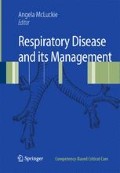Abstract
Pneumothorax is a relatively frequent occurrence in the intensive care unit (ICU). It may be procedure-related, due to severe underlying pulmonary disease and/or baro/volutrauma from mechanical ventilation. Some conditions, such as the acute respiratory distress syndrome (ARDS), predispose patients to develop pneumothorax and multiple air leaks may arise in individual patients during the course of their admission. Pneumothorax can lead to significant morbidity, particularly when it is under tension. Diagnosis is challenging in the ICU environment, and relies on a combina-tion of clinical skills and a number of different imaging modalities. Management involves drainage, implementation of a ventilatory strategy to mini-mize air leak and treatment of the underlying pulmonary disorder. Occasionally, surgical inter-vention—thoracoscopy, stapling of surface blebs, pleurodesis—may be required. Recurrence rates following such interventions are reported to be low.
Access this chapter
Tax calculation will be finalised at checkout
Purchases are for personal use only
Preview
Unable to display preview. Download preview PDF.
References
Henry M, Arnold T, Harvey J. BTS guidelines for the management of spontaneous pneumothorax. Thorax. 2003;58 Suppl 2:ii39–52.
Sassoon CS et al. Iatrogenic pneumothorax: etiology and morbidity. Results of a Department of Veterans Affairs cooperative study. Respiration. 2002;59(4): 215–220.
Chen KY, Jerng JS, Liao WY, Ding LW, Kuo LC, Wang JY, et al. Pneumothorax in the ICU: patient outcomes and prognostic factors. Chest. 2002;122(2):678–683.
Wait MA and Estrera A. Changing clinical spectrum of spontaneous pneumothorax. Am J Surg. 1992; 164(5):528–531.
de Lassence A, Timsit JF, Tafflet M, Azoulay E, Jamali S, Vincent F, et al. Pneumothorax in the intensive care unit: incidence, risk factors, and outcome. Anesthesiology. 2006;104(1):5–13.
Raptopoulos V, Davis LM, Lee G, Umali C, Lew R, Irwin RS. Factors affecting the development of pneumothorax associated with thoracentesis. Am J Roent-genol. 1991;156(5):917–920.
Despars JA, Sassoon CS, Light RW. Significance of iatro-genic pneumothoraces. Chest. 1994;105(4):1147–1150.
Kollef MH. Risk factors for the misdiagnosis of pneumothorax in the intensive care unit. Crit Care Med. 1991;19(7):906–910.
Kollef MH. The effect of an increased index of sus-picion on the diagnosis of pneumothorax in the critically ill. Mil Med. 1992;157(11):591–593.
Carr JJ, Reed JC, Choplin RH, Pope TL Jr, Case LD. Plain and computed radiography for detecting experimentally induced pneumothorax in cadavers: implications for detection in patients. Radiology. 1992;183(1):193–199.
Rankine JJ, Thomas AN, Fluechter D. Diagnosis of pneumothorax in critically ill adults. Postgrad Med J. 2000;76(897):399–404.
Lichtenstein DA, Menu Y. A bedside ultrasound sign ruling out pneumothorax in the critically ill. Lung sliding. Chest. 1995;108(5):1345–1348.
Lichtenstein DA, Mezière G, Lascols N, Biderman P, Courret J P, Gepner A, et al. Ultrasound diagnosis of occult pneumothorax. Crit Care Med. 2005;33(6): 1231–1238.
Alphonso N, Tan C, Utley M, Cameron R, Dussek J, Lang-Lazdunski L, Treasure T. A prospective rand-omized controlled trial of suction versus non-suc-tion to the under-water seal drains following lung resection. Eur J Cardiothorac Surg. 2005;27(3): 391–394.
Leigh-Smith S, Harris T. Tension time for a re-think. Emerg Med J. 2005;22:8–16.
Author information
Authors and Affiliations
Editor information
Editors and Affiliations
Rights and permissions
Copyright information
© 2009 Springer-Verlag London Limited
About this chapter
Cite this chapter
Sange, M., Langrish, C.J. (2009). Pneumothorax in the Critically Ill. In: McLuckie, A. (eds) Respiratory Disease and its Management. Competency-Based Critical Care. Springer, London. https://doi.org/10.1007/978-1-84882-095-1_7
Download citation
DOI: https://doi.org/10.1007/978-1-84882-095-1_7
Publisher Name: Springer, London
Print ISBN: 978-1-84882-094-4
Online ISBN: 978-1-84882-095-1
eBook Packages: MedicineMedicine (R0)

